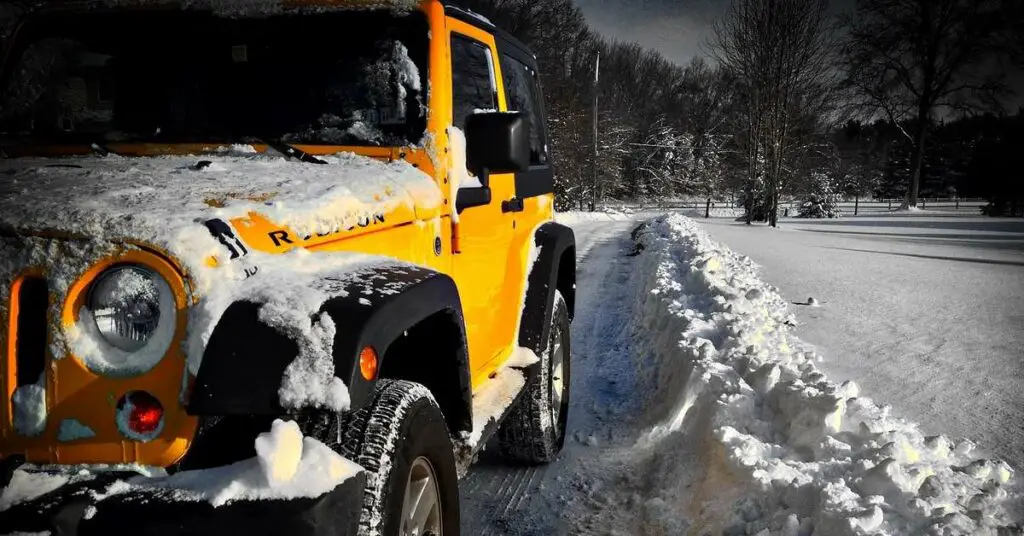
You’ve seen it on muddy trails and rocky terrains—heck, you’ve even admired it during your city commute. Yes, we’re talking about the iconic Jeep Wrangler. Known for its indomitable spirit and off-road prowess, this vehicle is a rolling embodiment of freedom and adventure. But what really gives the Wrangler its rugged edge? The answer is its 4-wheel drive system. If you’re scratching your head over how to engage this beastly feature, you’ve come to the right place. In this ultimate guide, we’ll go from zero to hero, teaching you how to master the 4-wheel drive on your Jeep Wrangler.
Why 4-Wheel Drive Matters
Let’s get real—you didn’t buy a Jeep Wrangler to stick to paved roads. You’re after the thrill, the challenge, and the freedom that only off-roading can offer. But to truly unleash the beast, you need to understand the magic of 4-wheel drive (4WD).
The Power of Traction
When you engage 4WD, you’re not just spinning two wheels—you’re putting the pedal to the metal on all four. That means more grip, more power, and fewer chances of getting stuck in mud, sand, or snow. The 4-wheel drive system distributes power to both the front and rear axles, leveling up your traction game like a pro.
When to Use What
You can’t just engage 4WD and call it a day. There are different modes for different roads. Whether it’s cruising on a rainy highway or conquering a rocky trail, each mode has its own set of rules and benefits.
| Drive Mode | When to Use | Benefits |
|---|---|---|
| 2H (2-Wheel High) | Daily commuting, dry conditions | Fuel efficiency, smooth ride |
| 4H (4-Wheel High) | Wet or slippery roads, off-road at higher speeds | Better traction, more stability |
| 4L (4-Wheel Low) | Extreme off-road, slow speeds | Maximum power, best for steep inclines or rough terrain |
By understanding when and why to use each mode, you’re not just a Jeep owner—you’re a Jeep master.
Understanding the 4-Wheel Drive Modes
Before you go switching levers and pushing buttons, let’s get familiar with the stars of the show: the 4-wheel drive modes. Knowing your 4WD modes is like knowing your tools before a DIY project. Each has a purpose, and using the wrong one could lead to a less-than-stellar outcome.
2H (Two-Wheel High)
This is your daily driver mode, ideal for smooth, dry roads. In 2H, only the rear wheels are powered, which is more fuel-efficient. If you’re cruising down the highway or meandering through city streets, keep it in 2H.
4H (Four-Wheel High)
Kick it up a notch with 4H. This mode is your go-to for higher-speed off-road action or slippery conditions like rain, snow, or loose gravel. All four wheels are powered, but they’re doing so at the same speed, offering a balance of traction and agility.
4L (Four-Wheel Low)
Welcome to the beast mode of 4-wheel drive. In 4L, your Jeep goes all out, delivering maximum torque to claw through tough terrains at low speeds. This mode is for those heart-pounding moments when you’re tackling steep inclines, rocky paths, or muddy trenches.
N (Neutral)
Neutral disengages all wheels, allowing your Jeep to be towed without clocking miles on the odometer. It’s not a driving mode, but it’s good to know what it’s for.
Quick Glance Table: Know Your Modes
| Mode | Powered Wheels | Ideal For | Speed Range |
|---|---|---|---|
| 2H | Rear | Daily driving, dry roads | Any |
| 4H | All | Slippery surfaces, off-road | Up to 55 mph |
| 4L | All | Extreme off-road | Up to 25 mph |
| N | None | Towing | N/A |
How to Engage 4-Wheel Drive: Step-By-Step Guide
Alright, enough talk. Let’s get into the nitty-gritty of actually putting your Jeep Wrangler into 4-wheel drive. Whether you’re a first-timer or just need a refresher, these steps will have you off-roading like a champ in no time.
Shifting to 4H (Four-Wheel High)
- Slow Down or Stop: You can switch to 4H while moving, but keep it under 45 mph. Or, play it safe and come to a complete stop.
- Shift Lever: Firmly but gently pull the 4WD shift lever from 2H to 4H.
- Check Dashboard: Look for a “4WD” or “4H” indicator light on your dashboard to confirm engagement.
- Foot Off Gas: If you’re switching while moving, lift your foot off the accelerator for a smoother transition.
Shifting to 4L (Four-Wheel Low)
- Slow Roll: Your Jeep should be rolling at a snail’s pace, ideally between 1-3 mph.
- Neutral Zone: Shift your automatic transmission into neutral (N). For manual transmissions, depress the clutch.
- Shift Lever: Move the lever from 4H to 4L.
- Back to Drive: Put your Jeep back into drive (automatic) or release the clutch (manual).
- Dashboard Light: A “4L” light should illuminate on your dashboard, signaling you’re good to go.
Back to 2H (Two-Wheel High)
- Slow Down: Reduce your speed to under 45 mph for 4H, or 1-3 mph for 4L.
- Neutral Again: Shift into neutral for a hot second.
- Shift Lever: Push the lever from 4H or 4L back to 2H.
- Check Light: The “4WD” or “4H” light on your dashboard should go off. You’re back in 2H mode!
Quick Checklist: Steps for Each Mode
| Action Step | 4H | 4L | 2H |
|---|---|---|---|
| Speed Range | < 45 mph | 1-3 mph | < 45 mph |
| Transmission State | Any | Neutral | Any |
| Shift Lever | 2H to 4H | 4H to 4L | 4H to 2H |
| Dashboard Indicator | 4WD or 4H | 4L | None |
Practical Scenarios: When to Use Each 4WD Mode
You’re geared up with the knowledge of 4WD modes and how to engage them. But theory is one thing; putting it into practice on the open road (or off it) is another. Let’s break down some real-world scenarios where each mode shines.
Daily Commute in 2H
Scenario: You’re cruising on well-maintained city roads or highways.
Best Mode: 2H
Why: It’s fuel-efficient and provides a smooth ride. No need for extra traction here.
Rainy Day Roadtrips in 4H
Scenario: The skies have opened up, and you’re dealing with slippery, wet roads.
Best Mode: 4H
Why: Better traction and stability, keeping you safe on slick surfaces.
Off-Roading Adventures in 4L
Scenario: You’ve hit the trails, facing steep inclines, rocky paths, or muddy stretches.
Best Mode: 4L
Why: Maximum torque and traction give you the power to conquer tough terrains.
Towing in Various Modes
Scenario: Hauling a camper or trailer for a weekend getaway.
Best Mode: Depends on conditions. Could be 2H, 4H, or even 4L for steep inclines.
Why: Use 4WD as you would normally, but with the added weight, it might be beneficial for steep grades or slippery conditions.
Scenario Quick Guide
| Scenario | Best Mode | Why |
|---|---|---|
| Daily Commuting | 2H | Fuel efficiency, smooth ride |
| Rainy or Slippery Roads | 4H | Improved traction and stability |
| Extreme Off-Roading | 4L | Maximum torque and grip |
| Towing | Varies | Depends on road conditions and inclines |
Remember, the right mode for the right road not only maximizes your Jeep’s performance but also ensures you’re driving as safely as possible.
Myth-Busting: FAQs and Common Misconceptions About 4WD
You’ve heard the terms thrown around—4WD, AWD, high, low, part-time, full-time. But what do they really mean? And what about those rumors you’ve heard? Let’s set the record straight.
Is 4WD the Same as AWD?
Fact: No, they’re not the same.
Why: AWD is usually on all the time, providing power to all four wheels. 4WD lets you switch between 2WD and 4WD. AWD generally lacks a low-range setting.
Can I Drive in 4WD All the Time?
Fact: Not advisable for part-time 4WD systems.
Why: You’ll wear out your vehicle faster and waste fuel. Full-time 4WD and AWD systems are designed for continuous use.
Do I Need to Deflate My Tires for Off-Roading?
Fact: It can help, but it’s not always necessary.
Why: Lowering tire pressure increases the tire footprint for better traction. But go too low, and you risk a flat. Always re-inflate afterward!
How Fast Can I Go in 4WD?
Fact: Speed limits vary by mode.
Why: In 4H, you should ideally stay under 55 mph. In 4L, keep it under 25 mph. Going too fast in 4WD can damage your vehicle.
Can I Switch from 2H Directly to 4L?
Fact: No, go through 4H first.
Why: Direct switching can cause mechanical stress and misalignment. Always transition through 4H.
Quick FAQ Guide
| Question | Answer | Explanation |
|---|---|---|
| 4WD Same as AWD? | No | AWD lacks a low-range setting |
| Always Drive in 4WD? | Not Advisable | Causes wear and tear, wastes fuel |
| Deflate Tires for Off-Roading? | Optional | Increases footprint but risk of flat |
| Speed Limits in 4WD? | Varies by Mode | 4H: < 55 mph, 4L: < 25 mph |
| Direct Switch from 2H to 4L? | No | Causes mechanical stress |
Getting the Most Out of Your Jeep’s 4WD System
You’re no longer a 4WD rookie; you’re a well-informed Wrangler wrangler. Let’s polish that knowledge with some pro tips. These will help you optimize your Jeep’s performance, whether you’re cruising city streets or conquering wilderness trails.
Regular Maintenance is a Must
Tip: Schedule regular inspections of your 4WD system.
Why: Preventative checks catch issues before they become expensive problems. Always check your owner’s manual for maintenance schedules.
Know Your Terrain Settings
Tip: Familiarize yourself with your Jeep’s terrain settings like Snow, Sand, Mud, and Rock.
Why: Each setting adjusts various vehicle parameters to optimize performance for specific conditions.
Listen to Your Jeep
Tip: Be mindful of any unusual sounds when engaging 4WD.
Why: Odd noises could signal a problem that needs immediate attention to prevent damage.
Don’t Neglect the Basics
Tip: Regularly check tire pressure, especially before off-roading.
Why: Proper tire pressure ensures optimal traction and fuel efficiency.
Experiment Safely
Tip: Test out 4WD modes in a safe, controlled environment before hitting challenging terrains.
Why: Knowing how your Jeep behaves in different modes can prepare you for any situation.
Pro Tips Quick Guide
| Pro Tip | What To Do | Why |
|---|---|---|
| Maintenance | Regular 4WD system checks | Prevents expensive problems |
| Know Terrain Settings | Read the manual, practice | Optimize performance |
| Listen to Your Jeep | Be alert for unusual sounds | Identifies potential issues |
| Don’t Neglect Basics | Check tire pressure | Ensures traction and fuel efficiency |
| Experiment Safely | Test 4WD in controlled conditions | Prepares you for various terrains |
Final Checklist: You’re Almost 4WD Ready!
Alright, you’re almost there. You’ve got the knowledge, the pro tips, and hopefully, a Jeep ready to hit the road—or the trails. But before you do, let’s go through a final checklist to make sure you’re 100% ready.
Before You Drive
- Owner’s Manual: Re-read the sections on 4WD for any model-specific quirks.
- Maintenance Check: Ensure your 4WD system is in top shape.
- Tire Check: Double-check those tire pressures!
- Test Drive: Take a quick spin in a safe area to test out 4WD modes.
On the Road/Trail
- Speed: Always adhere to the speed limits of your selected 4WD mode.
- Terrain: Use appropriate terrain settings for the conditions.
- Awareness: Listen for any unusual sounds; they could indicate a problem.
- Transition: Remember the proper steps for switching between 2WD and 4WD.
After Your Adventure
- Inspection: A quick once-over can help spot any potential issues.
- Cleaning: Mud and debris can affect performance; give your Jeep a good wash.
- Check Again: After cleaning, another quick inspection never hurts.
Final Checklist Guide
| Before You Drive | On the Road/Trail | After Your Adventure |
|---|---|---|
| Re-read Owner’s Manual | Follow Speed Limits | Quick Inspection |
| Maintenance Check | Use Terrain Settings | Cleaning |
| Tire Check | Be Aware of Sounds | Another Inspection |
| Quick Test Drive | Proper Transitioning |
That’s it! You’re ready to make the most out of your Jeep Wrangler’s 4WD system. Whether it’s a weekend adventure or a daily drive, you’re well-equipped to tackle it all.

As a seasoned mechanic and proud owner of three successful car workshops, I’ve dedicated my life to helping people just like you overcome their everyday automotive challenges. I created this website as a labor of love, with a simple mission: to make car maintenance and repairs more accessible and approachable for the “average joe.”
